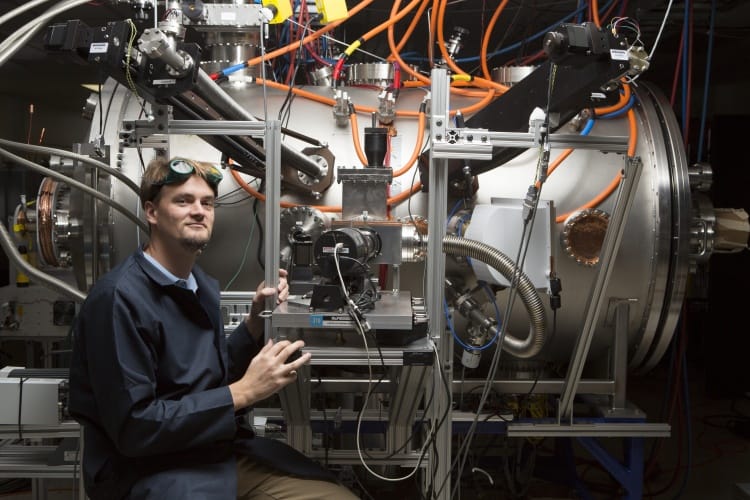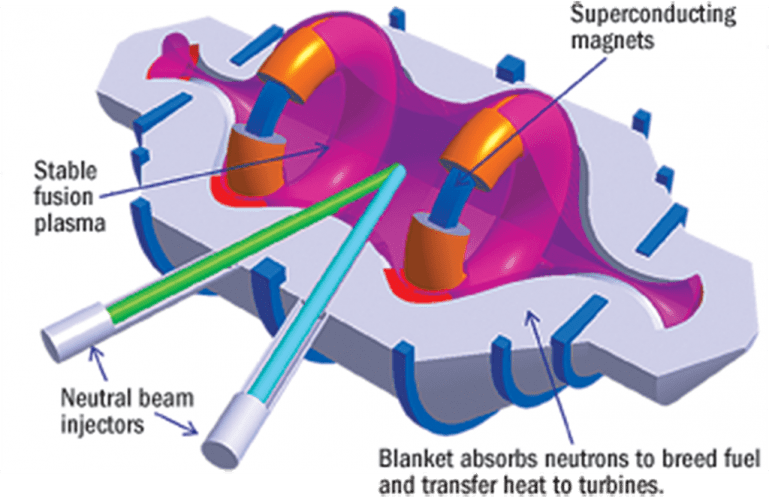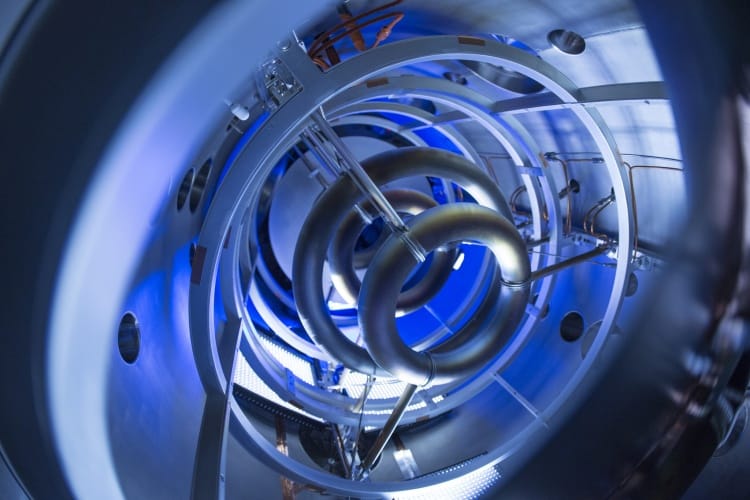Nobody could fail to have noticed that Lockheed Martin has made an announcement about a nuclear fusion project. I haven’t seen as much THIS WILL CHANGE THE WORLD FOREVER hyperbole since the height of cold fusion mania in the early 1990s. It’s understandable that people are excited — if it works, a fusion device the size of a jet engine would indeed be world-changing, producing zero-emission energy from abundant materials. But we also have to be a bit cautious and not get carried away.
’if it works, a fusion device the size of a jet engine would indeed be world-changing
The main source for these claims is not a peer-reviewed research paper or even an orchestrated launch by the company; it’s an article in the journal Aviation Week, including an interview with the lead researcher on the project, Dr Thomas McGuire of the company’s fabled ‘Skunk Works’ secret research site in California. It’s hardly surprising that this doesn’t tell the whole story, but we can’t tell whether this is Lockheed Martin being understandably cagey, or the reporting. It’s a shaky basis on which to assess whether this is really a breakthrough, or just a promising line of research that’s been reported at a perilously early stage.

Lockheed Martin, doubtless under siege from every science and energy journalist on the face of the planet, is holding a teleconference on Monday to discuss the project, but ahead of that I’m going to try to point out what we don’t know about the now-famous compact fusion rector (CFR).
Let’s start with what we do know. CFR is a magnetic-confinement fusion device, which means that it works by squeezing a plasma of positively-charged ions of deuterium and tritium — heavy isotopes of hydrogen — in a magnetic field and forcing them to undergo fusion, then collecting the energy emitted by the fusion reaction. In this sense, it’s related to tokamak reactors — large doughnut-shaped vessels surrounded by a complicated series of magnets which are the focus of much of the world’s fusion research, including the enormous (and enormously expensive) international ITER project in Southern France, which I have reported on extensively, as my regular readers (hello, Mum and Dad) will know.
’To get fusion to work, the plasma has to meet three basic conditions: it has to be clean; It has to be hot; and it has to be well-confined
CFR isn’t a tokamak, but it’s clearly related, so many of the same principles will apply. To get fusion to work, the plasma has to meet three basic conditions: it has to be clean, because any particles which aren’t deuterium or tritium nuclei, even electrons, can radiate energy and cool the plasma down. It has to be hot — really hot — because fusion can only occur when the positively-charged deuterium and tritium ions are touching, so they have to be travelling fast enough to overcome their electrostatic repulsion; temperature, when you’re dealing with gases, is just another way of talking about velocity. And it has to be well-confined, because that squeezes the plasma into a small space and increases the chances of collisions while also making it possible to extract the heat.
Now, all we have to go on are the diagrams of the CFR that Lockheed Martin has provided and we don’t know how simplified they are. Plasma cleanliness is mostly a factor of what the vacuum chamber is made of; it’s why ITER’s internal wall is made of beryllium rather than high-melting tungsten, which is a complicated atom with lots of electrons that could be dislodged by high-energy particles; or cheaper, tough carbon fibre, which could release carbon atoms into the plasma and lead to the formation of radioactive organic molecules: not something you want to happen. McGuire says the CFR is made of stainless steel, so we need to know what safeguards there are to prevent plasma poisoning.
Then there’s heat. The plasma needs to be heated to get fusion to start; when the energy from the fusion reactions themselves provides enough heat to maintain the required particle velocity then ignition is said to have occurred and the plasma is said to be ‘burning’. Nobody’s ever made a burning plasma and ITER is probably not even going to try; theoretically, the point where energy produced outweighs energy applied should happen long before ignition (although nobody’s managed that yet, either — the JET torus in Culham, Oxfordshire is going to attempt this next year).
In most tokamaks, three methods are used to heat the plasma. Two of the three sets of magnets — one running vertically down the middle of the torus and one set of concentric magnets positioned horizontally around its outside — are used to force the charged particles of the plasma to circulate around the torus; and as speed equates to temperature, this heats the plasma up. At the same time, radio-frequency transmitters (microwave emitters, basically) pump in energy, and devices called neutral beam injectors fire high-energy uncharged deuterium atoms into the plasma, where they are stripped of their electrons and give up their kinetic energy to the plasma through collisions. This raises the temperature of the plasma to many millions of Kelvin, hotter than the sun.
But the CFR diagrams show only the last of these three methods. As it isn’t a circle, you can’t introduce a plasma current in the same way as you would in a tokamak, and with only two magnets indicated, it’s far from clear whether you could manipulate the plasma in any way to induce a current. There’s no RF heating indicated either, so how does McGuire create the high temperature needed to induce fusion?

Then we come to confinement. The CFR’s interior seems to be shaped something like a wide-necked, pointy-ended hourglass, with circular superconducting magnets placed around the widest point of the ‘bulbs’. The magnetic field produced by the magnets would indeed be that shape, but can two magnets alone provide enough field to confine the plasma and stop it touching the vessel walls? McGuire says that the field is tunable, so the more the plasma tries to expand, the harder the field presses back; but there’s no indication of how this feedback loop works. Increasing the field strength is just a matter or increasing the current in the electromagnets, not a huge problem when the magnet coils are superconducting, but as field manipulation is crucial to the CFR’s operation there’s obviously much more information needed here.
There are other issues that Lockheed Martin will have to solve which are common to all fusion projects. Chief among these is probably tritium production. Being radioactive, hazardous and not available from nature, tritium has to be made using a by-product of the fusion itself – the high-energy neutrons emitted as tritium and deuterium form helium sail through the magnetic field and collide with lithium stored in a component called the blanket that lines the vacuum vessel walls. This transforms the lithium into more tritium. Tritium-breeder blanket research is being carried out at ITER and also at the National Ignition Facility, which is attempting fusion via a different mechanism at the Lawrence Livermore Laboratory elsewhere in California. There are several technologies that could be used, some using liquid lithium alloys, some using composites. Neither insitiution expects to complete their research in the five years Lockheed Martin claims it needs to produce a working prototype CFR capable of ignition. Are McGuire and his team working on something else?

The matter of the unit size also needs some scrutiny. Certainly, a jet engine-sized CFR would fit in an international-standard shipping container, as Lockheed Martin says. But it can’t work on its own. It also needs a cryoplant powerful enough to maintain temperatures only a few Kelvin above absolute zero in the magnetic coils, a tritium plant to remove the tritium from the breeder blanket mentioned above, purify it and pump it into the reactor, the sizeable equipment for the neutral beam injection (and any other heating apparatus), and the electrical transformers to power all this stuff. Will that all fit in the same container too? And what about the shielding necessary to protect people from the neutron radiation caused by fusion?
And how about the steam generators? McGuire talks about the CFR as being a plug-in unit that can provide steam to existing generating turbines. So we also need water (or another coolant) circulating in the blanket component to remove the heat of the fusion reaction, and heat exchangers to use that heat to make steam for the turbines. Add the pumps for that to the list of things that has to fit in that container, along with more shielding because the coolant will be radioactive.
Now, for comparison, an EPR fission reactor like the ones that will be built at Hinkley Point C have four steam generators to power the new station’s turbine hall. Each one is the size of a train carriage. So if a single CFR prodcues as much energy as a tokamak ten times its size, as McGuire says it will, will it also need a fleet of mobile steam generators? This wouldn’t be insurmountable, but it would be costly; they’re complex chunks of engineering, so it’s something we need to know.
This isn’t an exhaustive list, but it sheds enough doubt for us to remain cautious. It is of course possible that Lockheed Martin can answer all of these questions (and any others that readers might like to suggest) on Monday afternoon. I’m looking forward to finding out, and to explaining it to Engineer readers on Tuesday, and I sincerely hope it doesn’t fall as flat as cold fusion did.




Red Bull makes hydrogen fuel cell play with AVL
Formula 1 is an anachronistic anomaly where its only cutting edge is in engine development. The rules prohibit any real innovation and there would be...